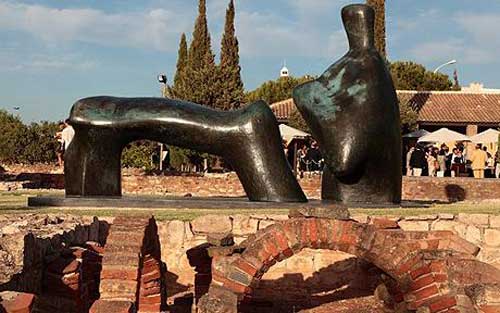
 Sculpture News at SculptSite.com
Sculpture News at SculptSite.com
Jose Berardo a Collector of Sculpture |
 |
| Henry Moore?s monumental Reclining Figure: Arch Leg, from 1971, cost just over £1 million in 1995 ? a record for Moore at the time |
| Telegraph.co.uk By Colin Gleadell Jose Berardo interview for Vilamoura Sculpture Park in the AlgarveColin Gleadell interviews the Portuguese art collector about a new sculpture park in the Algarve, of Berardo's contemporary British sculpture. Portugal's biggest modern and contemporary art collector, Jose Berardo, was out in the Algarve sun last week for the unveiling of 10 monumental sculptures by British artists from his collection as part of a 40 million euro campaign to boost the cultural appeal of the golf course-studded holiday coast. In Florida, golf clubs are used to display and sell outdoor sculptures to wealthy collectors. In the Algarve, the chosen spot is an archaeological site in the Vilamoura resort, where the remains of a Roman villa have been excavated. "I like the juxtaposition of the old with the new," says Berardo, dressed in his customary black crew-neck shirt and suit. So, clearly, did the tourist board. Now 66, Berardo is a self-made man, amassing a fortune in South Africa from gold and diamond mining, which he then diversified into a wide variety of investments. An inveterate collector, he started as a schoolboy with stamps, postcards and matchboxes and graduated to modern and contemporary art in the Eighties. His various collections, which include art deco and Chinese porcelain, encompass more than 40,000 works, of which some 1,200 are by well-known modern and contemporary artists with a value, he has said, of $750 million (£486 million). So far, he claims never to have sold a thing, though that might change. I first heard of Berardo in the early Nineties when his then adviser, Francisco Capelo, was a familiar figure in the London salerooms, building what was to become a very fine collection of English pop art. The market was in recession, so it was a good time to buy, and Capelo paid top prices for vintage works by Allen Jones, Joe Tilson, Hockney and Hamilton. One of his favoured galleries was Whitford Fine Art. Another was the Lisson gallery, where he was a major buyer of works by Tony Cragg and Richard Deacon. His range was encyclopedic, stretching from Mondrian to Bacon and Warhol, taking in en route virtually every Western avant garde movement of the post-war era. Berardo went public with his collection in 1997, displaying works at an old casino in Sintra, and then in the Belém Cultural Centre in Lisbon. In 2006 he came to an arrangement with the Portuguese Ministry of Culture whereby the centre would be renamed the Berardo Museum, but the ministry would manage the bulk of his collection with the option of buying it after 10 years - much as the Spanish state did with the Baron Thyssen collection in Madrid. Some of the sculptures in the Algarve, which will be there for the next year, are part of this arrangement. Fleet, a classic 1971 sculpture of painted steel girders by Anthony Caro, was bought in 1988 for £22,000 - not much by today's standards, but at the time it was the second highest auction price for Caro. Henry Moore's monumental Reclining Figure: Arch Leg, from 1971, cost just over £1 million in 1995 - a record for Moore at the time. Most of the works on display, however, have no such ties. They are managed by Berardo personally because they were bought later, in 2007, from the Cass Sculpture Foundation, a charitable trust which commissions outsize sculptures and displays them in woodland in Goodwood, Sussex. Wilfred Cass, the charity's co-founder, said the sale of eight recent works by Lynn Chadwick, Allen Jones, Tony Cragg, Zadok Ben-David and others was the largest single sale he had ever made to a European collector, though he would not disclose the price. Since then, however, Berardo has been less active. His fortune, estimated by Forbes in 2008 at $1.8 billion, fell sharply the following year to $1 billion. This year he was dropped from the billionaires list, his wealth assessed by the Portuguese press at $760 million. He has not been buying so much, he told me, because contemporary art has become so expensive. Much of his art collection has been used as collateral to borrow from banks. Sweeping aside suggestions that he doesn't own his collection any more, he does concede that, in the long term, he is less worried about ownership than about the visibility of the art in the collection and its educational role. "I want to promote history," he says with a grand gesture around the Roman ruins where his sculptures stand - some comfortably, others a little incongruously - like a playground in the sun. History indeed - and tourism. Most of the tourists have now left the Algarve. Vilamoura is peaceful and uncluttered; but there are plans for it to become the biggest holiday resort in Europe. Next summer, it is hoped, Berardo's British sculpture, signposted on all the local roundabouts, and visible from some distance, will be pulling in the crowds. |
 I have never met Mr. Berardo. I sure would someday, if it is just to shake his hand and thank him for what he has done for the art world. Especially sculpture - OK I'm biased! Thank you Colin Gleadell for a nice read of your interview with Mr. Jose Berardo. |
More Sculpture News ....
Submit your SCULPTURE NEWS.
It's easy, just send us an e-mail
(click on Submit News in the left menu) with your pertinent information along with images, we'll take care of the rest. Sculpture makes our world a much better place in so many ways!
SculptSite.com, along with Sculptors and their creative genius all helping to bring the beauty and message of Sculpture to a hurried world.

